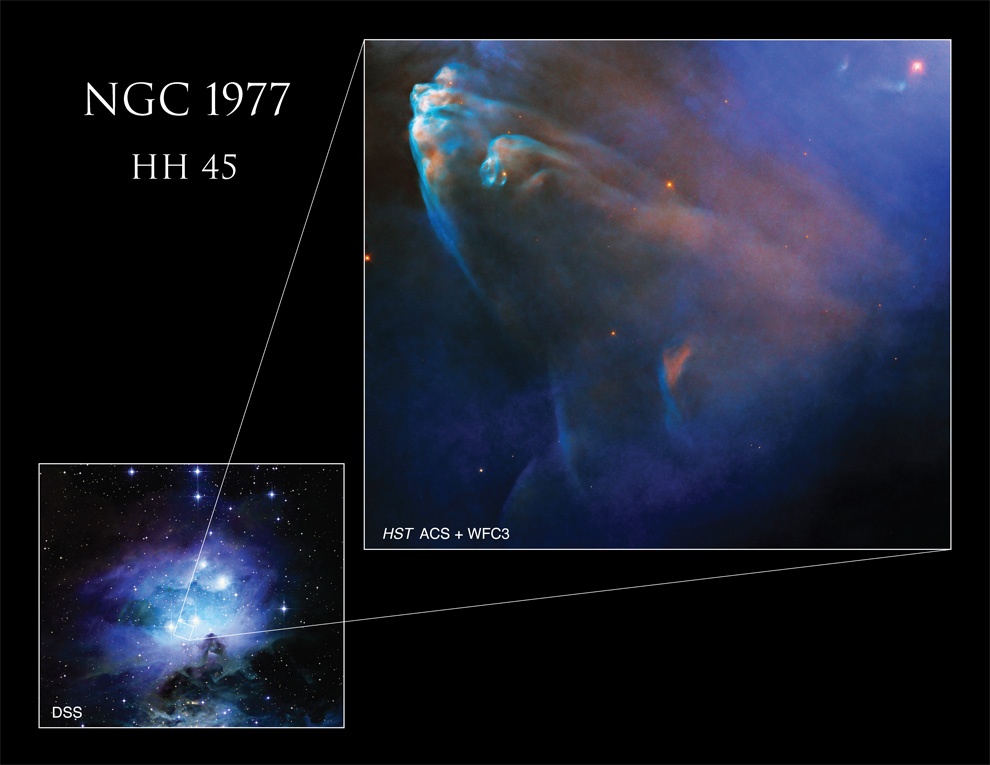Colliding Gases at the Heart of the Running Man Nebula
By Matt Williams
Behold, the Herbig-Haro object known as HH45, captured by the Hubble Space Telescope (HST)! These objects are a rarely seen type of nebula made up of luminous clouds of dust and gas. These occur when newborn stars form within a nebula and eject hot gas, colliding with the surrounding gas and dust. The result is bright shock waves that look like mounded, luminous clouds in space!
In this image, HH45 is shown inside the nebula NGC 1977, part of the larger three-nebulae complex called the Running Man. The Hubble image managed to capture the clouds of ionized oxygen (O II) and magnesium (Mg II), indicated in blue and purple (respectively). These elements are of particular interest to researchers since they can identify shocks and ionization fronts with these objects.

Along with its companions, NGC 1975 and NGC 1973, NGC 1977 is one of three reflection nebulas that make up the Running Man Nebula located in the constellation Orion (just north of the massive Orion Nebula). The term reflection nebula refers to clouds of dust and fast that don’t emit light on their own but reflect light from nearby stars. In the case of NGC 1977, the entire region is excited by the hot young star 42 Orionis (HD 37018).
On the same day that the HH45 image was released, NASA released a second image (shown below) of a stellar jet inside NGC 1977 visible to Hubble. The orange plasma jet (visible at the bottom center of the image) stretches over two light-years through space and was emitted by the young star Parengo 2042. This star is embedded in a disk of debris that could give rise to planets someday.
The red and orange colors in this image indicate the jet and the related glowing shocks waves, which are visible because of how they are powered by the radiation of a nearby star – 42 Orionis. While this star isn’t visible in the image, its bright light can be seen entering the frame at the lower right and extending across the bottom half of the picture.
On the right side of the image, there are glowing blue ripples that look like they are flowing away from the jet, which are bow shocks facing 42 Orionis. In space, bow shocks happen when streams of gas collide and form crescent-shaped waves, similar to what ships at sea leave in their wake. Similarly, the bright western lobe of the jet is surrounded by a series of orange arcs that diminish in size with distance, forming what appears to be a conical shape.

Jets like this are particularly useful to researchers because the outflowing gas remains visible thanks to the ionizing radiation of nearby stars. Ordinarily, outflow jets are only visible when they collide with surrounding gas and dust, creating bright shock waves that disappear once they cool. It also provides a visual representation of what Hubble was looking for while observing this nebula.
Basically, Hubble observes reflecting nebulae like NGC 1977 in the hopes of witnessing stellar jets and planet-forming disks. The overall aim is to learn more about how debris disks from which planets form are affected by ionizing radiation and other factors in their local environment. Data obtained from these types of observations campaign ultimately allow astronomers to improve their models of planetary formation and help address the deeper questions of how and where life can emerge in our Universe.
The post Colliding Gases at the Heart of the Running Man Nebula appeared first on Universe Today.

December 6, 2021 at 11:39PM
via Universe Today read more...

Post a Comment